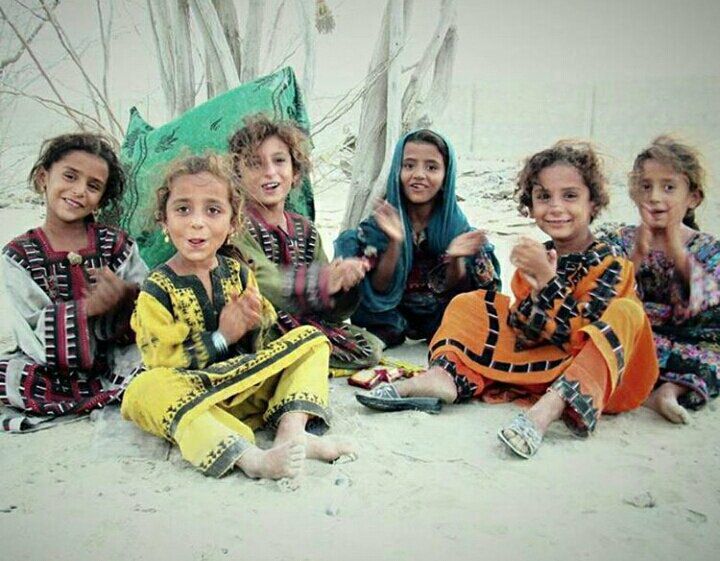The Rich Baloch Culture
Baloch culture is rich, varied and deep-rooted. There are certain characteristics which have become the hallmark and the distinguishing traits of the Baloch. Some of these characteristics are: bravery, fearlessness, honesty, loyalty, friendship, righteousness, sincerity, integrity and simplicity. Like every other nation who has been suppressed and kept back-ward, Baloch are traditional in the sense they are rather resistant to change their norms and values but are also liberal. After all it was their cultural cohesion that made them survive throughout centuries of brutal and barbaric attacks and killings by outsiders. However, emphasis on tradition should not portray a picture of Balochistan with nomads and camels moving around and life as it was many centuries ago. Indeed Balochistan, despite deliberate deprivation by the ruling governments of Iran and Pakistan, is a modern place with a secular and liberal society. The Baloch are very hospitable, nice and friendly. They are generally intelligent, learned, well-informed, initiated, cultivated, socially accomplished and politically attentive. Culturally, they are rich and self-dependent. A Balochi way of living;
Baloch Names & Titles
Traditionally the name of a child was chosen a few days after birth, mostly on the sixth.The child was given a name of some worthy forefather who was not alive.But at the first instance, he was given an alternate name.As the Baloch had great respect for their departed elders, they gave names to the children formally, but in the meantime alternate names were chosen because the children by those would be receiving rebukes, which was considered an insult even to those names and always avoided.
The Baloch borrowed names from animals, trees, plants, colours and even parts of the body. Names were also derived from the name of week days.
Father’s name was sometimes added to the actual name, as Chakar-e-Saihakk (Chakar son of Saihakk) or Haibitan Murad (Haibitan son of Murad).This practice most probably has crept into Baloch culture through Arabic influences at a much later stage.
Dress & Jewellery
The Baloch wore a jamag, along shirt, down to heels and loose trousers; a turban, pag and shoes made of leather or sawas, made of palmyra, piss.The jamag had side pockets. Like their Aryan ancestors, they always wore white.In recent times over-coat or waist-coat, kaba, which was usually embroidered in different colours was used by noblemen.Sal orchadir which was a mark of distinction was used by elderly persons who warped it round the waist and knees, called kabarsani, to sit in a particular position in Balochi diwan. Socks have also been in use.
Women also wore loose shirts or gowns and trousers.Primitive women used only a large loose shirt which covered her from neck to the feet and usually did not wear trousers.The gown was ornamented with a profusion of needle-work of various matching colours. The shirt had a large front pocket, pandol, near the knees which was also embroidered.She had achadir or gusan on the head which also covered the neck and breasts.Women wore shoes and socks.Virgin and widows usually wore black jamag; and among some tribes white, without any embroidery, while a married women used various colours, the favorite being red.The married old women sometimes used black shirt without embroidery.They did not use any jewelry or ornaments.If a widow used embroidery , it was a clear indication that she intended to re-marry.
Men had long hair while the women’s long hair was parted in the centre of the forehead.This separation was called giwar. The hair was beautifully managed in two and left down back.Women in some areas used amad, a black tooth paint.The head was usually bound with a fillet or black stuff or silken cloth. Tituk or tattooings were made on women’s forehead and cheeks, especially of newly married girls.
In ancient times the customs of burying the dead with garments and ornaments was perhaps the most archaic use of jewelry. Purely decorative jewelry had existed since the beginning of the Christian era.The Baloch use of jewelry has close affinity with the Aryan’s traced from the archaeological findings.The primitive Baloch thought that garments or jewelry could ward off evil and protect persons from vicious elements.Such beliefs also existed among most other people. The Baloch believed that some evil forces who were in search of opportunity to harm human beings could be checked by the use of jewelry.The bridegroom besides his usual ornaments, such as a sword, had some hidden object on his person during, at least, the first night of the marriage.
The women wore durr (earrings), pulu and pulluk (rings in nose), har or touk (necklace and bracelets), mundrik (rings in hands and foot fingers), sanga or tal (rings around hands),bahuband or bahink (armlets).Ornaments of various kinds were fixed on the heir including choti-pull, moudi, which are fixed on the hair near the back, and tall which was added to make the hair appear long.
Birth of a child
The occasion of the birth of either a male or a female child was marked with much music and singing.The women folk attended the mother for seven nights and sang sipatt or nazink, literally meaning songs of praise.Food and sweets were prepared and distributed.The birth of a boy was greeted with greater rejoicing than the birth of a girl.Among some tribes no ceremonies were performed on the birth of a girl, while among other tribes usual ceremonies were performed from birth to death.They included birth, sasigan (selecting name on sixth day), burruk (circumcision), padgami (child’s beginning to walk) and salwar (wearing of trousers) etc.
Marriage
Marriages which generally took place after puberty were performed with ceremonies which included music, dancing and distribution of food.The girl was usually a few years junior to the boy.Marriage was arranged to a closely knit family.Expenses of food prepared on either side was borne by the bridegroom.To meet the expenses and amount of labb, bride price, relatives of the bridegroom collected bijjari, subscriptions from friends and relative.Traditionally, everyone who was asked gave according to his means. Sheeps, cows, goats or camels were also presented as bijjar. Relatives of the bride also collected bijjar called giwari on the marriage evening.
The general characteristics of a wedding included negotiations by parents and other relatives.All details were agreed upon and the wedding was formalized later on. Labb was fixed before hand.Sang or harbarsindi, betrothal, was the first step. The expenses, pardach, was incurred by the bridegroom. Pardach was paid in cash and kind before by the marriage date.It also included embroidered clothes and other essential articles for the bride.
Sang was almost as absolute as the marriage itself.After engagement, the parents of the girl were bound to give the hand of the lady to the person to whom she was betrothed.There was no backing-out from either side save in exceptional circumstances.Only in rare cases, could the man forego his fiancée, distar.
Sahbadal or system of exchange of girls between families without stipulations paid was also prevalent.Sometimes conditions were made that a daughter born of a marriage would be given to relations of bride’s parents.However, if there was a marked difference in the ages or personal attractions of would-be-bride and bridegroom, it would then be compensated in money by either side.Betrothal in childhood among close relatives was also common.
The date of marriage was usually announced well in advance and all the relatives and friends were duly informed.In former times, the invitation for participation was sent to the entire clan which then selected the individuals for taking part in the ceremonies on their behalf.However, at a much latter stage, the invitations were sent to individuals and family heads.The persons sent for inviting the people, Lotuki, included singers and dancers who started singing and dancing before entering a village.The party would then be feasted by the village headman before their return.
A few days before the event, a kapar or a large wooden tent was built, a few yards from the home of the bridegroom.In coastal areas this temporary tent was called mangeer where more than on marriage ceremonies were performed.This was built for the occasion by the people under supervision of the village headman. All ceremonies including dancing and singing were performed there.This would also serve as a guest house for visitors from the nearby villages.Among peculiar customs, korag, was most prominent.The bridegroom was taken a few furlongs outside the settlement, as the word connotes, most probably to the riverside, in the evening, where arrangements were made for his bath and make-up.He would then mount no horseback or camel and was brought to diwanjah or mangeer amid much singing and dancing.
Another peculiar custom was that a week before the marriage, the girl was secluded from the rest of the family.Only the closest female relatives and friends could visit her.During this period she was also briefed regarding her duties and responsibilities after marriage
After sun-set the bridegroom profusely arrayed, accompanied by close friends and relatives moved to the bride’s house where proper arrangements were made. Formal wedding was performed after the guests were feasted..
Deewan
The Baloch had an open society with its unique characteristic of equality and freedom, which is now deep-rooted.Every Baloch was expected to be active member of the tribe.He took part in discussion in diwan which was open to everyone, at the house of the Sardar or the elder. Sometimes there were separate place, diwanjah, for such gatherings. Social, political and economic problems concerning the tribe were debated in these assemblies. Diwan literally means gathering or assembly.
Diwan in it formal nature was to be participated in by the elders and elected personalities. In all informal get-together everybody felt his presence.This spirit had made the Baloch into a close knit tribal structure based on mutual benefit and loss.
The house of the leader, or diwanjah was the place where history, legends, ballads, drama, lyrics and tales of love were told and sung.Every one wished that he could exert himself and attract others by his knowledge and manners during such discussions.
Music & Dance
The Baloch has a rich musical culture.His interest in music was profound.It is possible that like other civilizations, music among ancient Baloch had functions connected with religion.However, its ecstatic and secular possibilities nevertheless had relation with some form of magic.The Baloch treated persons suffering a type of disease similar to hysteria or chronic indigestion through music. They were called Gwati. Minstrels played music on sorouz and tamborag and repeated often one particular rhythm.When the music reached its climax the gwati started a relentless movement in a dancing pattern.This would continue for many hours til late at night.It was believed that music would construe some magical effect, and that disease which had been caused definitely by some evil forces would end.
Music had its importance on all occasions except death when the ceremonies were of a more solemn nature.Other occasions were marked with much singing and dancing.
The Balochi sur or raags which could be termed Zaheerag because of their general characterization of melancholy pattern, could be categorized under two main heads: Balochi and Kurdi.All others which may be as many as twenty come under these heads.Under Balochi, comes its various branches: miedi gor-obam, mianag, asrap-e-durra and janozam.Kurdi included baskard jalawani kurdi, sahr kurdi, salat and tat. It may, however, be noted that the entire Balochi musical structure is based on Zaheerag. Some of the folk-music appears to be somewhat different from it, but in their formal structure all musical derivatives have their base in Zaheerag.
Among the musical instruments nal-sur, tamborag and suroz were important.
Religious dances were not prevalent.However, in the more recent past, Zigri sect, among the Baloch, practiced a kind of religious dance called chogan. It, however, varied much from classical temple dances of most ancient cultures.
The main dance was do-chapi when men gathered and danced, clapping hands with the movement of foot, nech and head on rythmical music on drum, dohl. Any kind of dance apart from do-chapi was not universal. Basically it was for the enjoyment of performers and was not a spectator dance.On many occasions women moved in a circle, clapping hands but without any body movements such as do-chapi.
Lewa, hambo and latti were also prevalent mostly through foreign influence. Lewa is supposed to be of Arabian origin, while Latti and Hambo were clearly dances of the ancient indigenous people of Balochistan.
Hal was giving and receiving news when one chanced to meet another.It was an obligation, and always reciprocal.A person must communicate the latest happenings which may include the prices of essential goods in a nearby market or some political events o a more serious nature.This helped in conveying the latest happening in remote areas.When travelling in groups, the hal was given by the elderly person of noble birth.This was called chehabar. To reveal or receive hal was a mark of distinction.
MESTAGI
Mestagi was the reward for giving good news as birth of a son, news of the arrival of a lost relative or report of a victory in the battle.It was appropriate and according to the good news conveyed.
Crimes & Punishment
A very peculiar cultural trait was that even the criminal or offender, if apprehended, would never tell a lie even in the face of instant punishment.This was against his sense of honour and pride.He was always truthful.This made torture to extract information or confession of guilt quite unnecessary.
Among the ancient Baloch, like other Aryan groups, trial by ordeal was perhaps in vogue.The culprit had to prove his innocence by walking through the fire or putting his hands on a hot rod.In Balochi folk stories there are numerous instances when the innocence of the offender had to be proved by putting his hands on the hot stones, tapag. This practice was perhaps discarded early in the Christian era.
In most cultures any child of less than then years was usually considered incapable or guilt on the ground that he or she was too young to differentiate between right and wrong.The practice was completely reversed among the Baloch. The Baloch child had a penetrating sense regarding his enemies and friends.Old blood accounts sometimes were settled by persons of less than ten years.A Baloch child took part in battles.Therefore, the case of guilt or criminal responsibility for the minor was always judged according to circumstances and merit of the case.The members of the family of the minor would have to bear the responsibility of his guilt if the crime was provoked by them
The home of any Baloch elder was a safe refuge and place of protection for all the offenders of law till the decision of the dispute through the Jirga or med.
Source: Social Media










